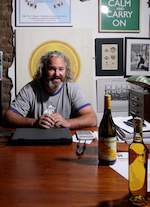This is one of the reasons why the 'new· traditionalists like Adi Badenhorst are being guided by the Mediterranean climate and variety of soils of the area in which they find themselves at home.

Hence the focus is on varieties such as shiraz, grenache, Mourvedre, and Cinsaut (Cinsault) for reds; and exploring viognier, grenache blanc, Roussanne, and Clairette Blanche as accompaniments to versatile classic Chenin Blanc for white wines.
Adi's rich, rustic wines are standard-bearers in philosophy and quality, waving the flag locally and internationally. The premium AA Badenhorst Family Wines Red and White are made in limited quantities. 'The white is usually a blend of 10 different varieties with steen [chenin blanc] being the heart and backbone of the blend,' says Adi.
For the more widely available 'working man's bottlings under the apt Secateurs label - the white is currently a pure Chenin Blanc - he also sources grapes from his neighbours. 'Hence Secateurs is known as the world's smallest "co-op"!'
His wines attract attention as much for their labels as for what's in the bottle: a broad blue or yellow band across the cream stock paper with bold, decorative, earth brown script offset by frilly twirls, scrolls, grape bunches and leaves, and drawings of a three-headed swan and tiny mice, a beetle, a Cape fox and a pair of secateurs. 'The beetle, also called a kalander, is the snout beetle, a vineyard pest, after which we named our feisty little girl: Ana Kalander! The fox is known as the draaigat jakkals and the farm is just off the Jakkalsfontein road.'
The back labels include the barcode morphing into the leaves of a kalmoes - an aquatic plant only found on Kalmoesfontein in the Paardeberg - and a list of varietal ingredients in precise percentages. It's the story of growing and making wine the natural way but with meticulous attention to detail.
The home of Adi's wines is a nineteenth-century cellar, last used in the 1930s and recommissioned when Adi and cousin Hein Badenhorst bought the dilapidated 60-hectare Kalmoesfontein in 2007 from Pierre Roussouw, who still tends the vines.
The building sits on a slope at the entrance to the Siebritskloof, facing the expanse of the Swartland to the Voëlvlei and Elandskloof mountains. Beside it is the spartan original farmhouse, partly sans ceiling with brickwork, wooden beams, and tin roof exposed in rudimentary restoration. and divided into a tasting and 'party' space, storage area, and Adi's 'office'.
The latter could be a typical small Afrikaner Karoo town general dealer's shop: a treasure trove of weird and wonderful collectibles, from a mounted buck's head and stuffed birds (Adi has an aviary and used to breed parrots) to blocked Tintin posters and family photographs. Among the captivating clutter is a wooden desk, 1970s upholstered couch, and glass-topped display cabinet filled with fascinating bits and bobs.
'The house needed some work but Cornelia sorted it all out. Every time I'd been away and come home, she'd knocked out another wall!' They've opened the living areas up and out onto a large front stoep, partly under cover of a latte [reed] ceiling where they braai.
 Swartland eggs benedict with sweet potato rösti with fresh asparagus recipe by Adi Badenhorst paired with AA Badenhorst Family Wines White....
Swartland eggs benedict with sweet potato rösti with fresh asparagus recipe by Adi Badenhorst paired with AA Badenhorst Family Wines White.... Sweet wine jelly with greek yogurt and stewed rhubarb recipe by Adi Badenhorst....
Sweet wine jelly with greek yogurt and stewed rhubarb recipe by Adi Badenhorst....